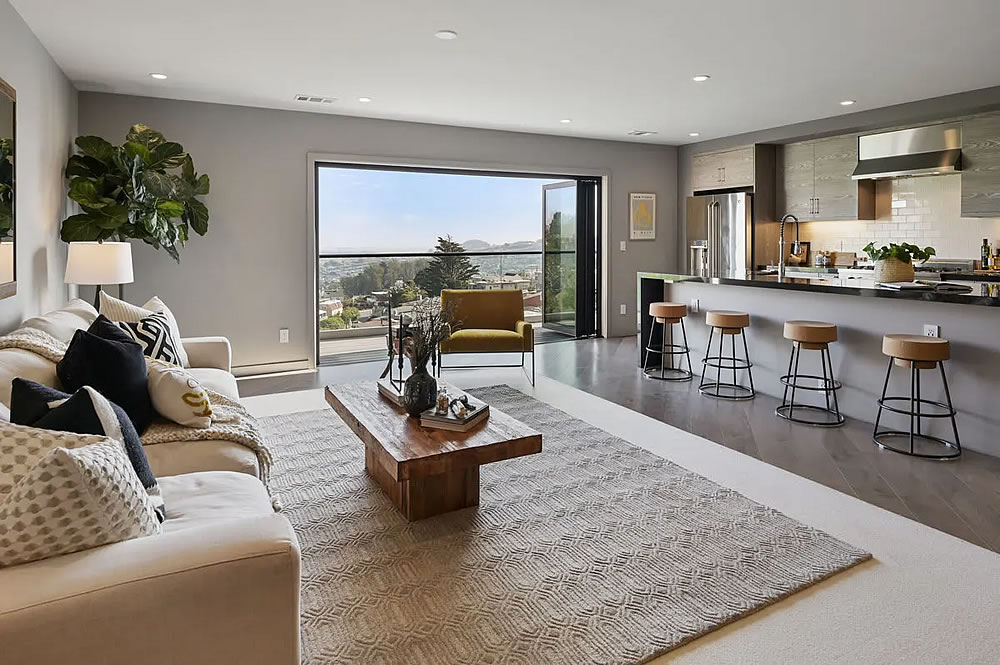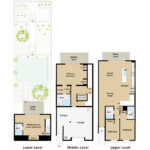Purchased by an interesting group of investors for $1,152,000 in July of 2015, the 1,550-square-foot Miraloma Park home with panoramic views and expansion potential at 701 Teresita Boulevard was foreclosed upon in June of 2016, selling for $942,000 in cash on the courtyard steps, with permits to renovate and expand the home having been secured but not executed.
Completely remodeled and expanded to 2,400 square feet in 2017, the now three-level, four-bedroom home with multiple decks, walls of sliding windows and contemporary finishes, including a Bertazzoni in the kitchen and an EV charger in the garage, then sold for $2,250,000, or roughly $938 per square foot, that September.
Having returned to the market priced at “$2,249,000” last month, a sale at which would represent no appreciation since the third quarter of 2017, the “Miraloma Stunner” is already in contract.
If you think you know the market for Miraloma Park homes, now’s the time to tell. Keep in mind that the Case-Shiller index for single-family home values in “San Francisco” is up 39.9 percent since September of 2017.
The sale of 701 Teresita Boulevard has now closed escrow with a contract price of $2.8 million, up 24.4 percent on an apples-to-apples basis since September of 2017, or just 5.0 percent per year, and 24.4 percent “over asking!” versus a 41.0 percent increase in The Index with an extra month of data in hand.










My guess was 2.7 give or take – basically nailed it. Wish my Tahoe gambling bets were as good. LOL!
The takeaway is the significant underperformance of this and most SF homes in terms of Case Schiller. I live in Miralem Park a street away and above this home. The homes in Miraloma have not gone up 18% over the past year which is the Case Schiller number. The actual appreciations seems to have been 9% or so.
This is a reminder that Case Schiller is a regional, not local, index. Places in the Oakland Hills, Walnut Creek and other East Bay locales have had robust appreciation – some more than 18%. The same goes for certain parts of the Peninsula. The CS numbers don’t tell the true picture of what is happening with SF SFH’s and condos.
A 24.4 percent gain since September of 2017 actually equates to 5.0 percent per year (versus an annualized gain of 8.0 percent for the index).
I can’t understand the take aways. “significant underperformance” of SF in this case is a good thing right?
Shouldn’t we be like “thank god SF isn’t going up at the crazy rates of the Bay area”. It’s just going up at a steep clip from all time highs which already seems like to much. If this place followed the CS it would have gone for $3.125. Does anyone think that would be a positive?
Yes. The real estate agent who had the listing, and whose “rip” on this sale depended on the the nominal selling price, would have thought that would be a positive.
I don’t know. Even the agent might think “I made $58k, but if I only made $50k (ie a $2.5m price) I might be able to put my other 3 clients into houses”
Yes, but that those 3 theoretical other clients out there is the reason why the sale price ended up being higher. The supply is on a curve – more people are willing to sell at higher prices. Demand is on a curve as well – more people are willing and able to buy at a lower price. Where those curves meet is where the deal closes and prices are set, both on a micro and macro level. But home selling is tricky as you can’t just add to the supply very quickly and people who are settled in generally tend to just stay in their place. E.g. someone who 10 years ago may have said “if someone offered me $3 million for this place, I’d sell in an instant and retire,” now, when the place could actually fetch that sum, just stays put unless some life issue drives them to sell, like retirement, medical problem, divorce, new job, etc. We’re still in a market where there is far more demand than supply (technically, where the supply and demand curves match is at increasingly higher prices levels). So this “just right” world where sellers would be willing to sell at $2.5 million even though there is a buyer willing to pay $2.8 million isn’t going to happen. Markets can change. SF changed big time in 2008-2012 where demand dried up relative to the supply (the curves met at ever-lower prices). But we’re not there yet. We’re closer with condos, thanks to tens of thousands of new units in recent years changing the balance, but sellers still have the leverage even there (after a short period in 2020 when people fled the city). For realtors, at least volume is higher these days than it’s been in recent years.
The time to buy a condo was last summer and back 15 months from that. The sector is hotly competitive again. That said, here “condo” is a wide ranging term. One bedrooms and older type conversion lofts remain relatively good condo deals. But a 2 br or better with parking in a good area? Those type of properties are in a sellers’ market.
Zillow says SF homes are up 10% YOY which aligns with what I’m seeing in the Mt. Davidson area. SSF is up 16%. Oakland 15% and Contra Costa County over 19%. Generally, SF is lagging the rest o the Bay Area in home appreciation but, within the context of SF proper, this home seems to be more or less tracking the average.
There’s a reason Zillow had to exit the home buying business despite their “market analytics” and Zestimates (that weren’t accurate enough to be useful to the company itself beyond marketing and generating page views).
I have always felt that prices can only go up so high due to the reasonable income / assets of a household. And yes, the more desirable neighborhoods will go up to that limit and then plateau a bit, increase less, and then some other neighborhood would get hot and their prices would go up at a high rate then hit that limit (right now, my totally unscientific guess is about $2-2.5 mil, which is what two working professionals with help from their parents can afford) and then slow down.
Living in SF for 10 years, I’ve seen Noe and Dolores Heights get hot, then Bernal, now Sunset, and probably Excelsior / Crocker Amazon next. The older neighborhoods continue to be more desirable and expensive, yes, but they’re not going to increase at the same rate.
And enter the specter of rising mortgage rates from their all-time lows, in terms of purchasing power and affordability.
Every single one of those neighborhoods has been quote unquote “hot” for months tho.
That neighborhood is known quaintly as “Pneumonia Gulch” as the summer weather (read fog and wind) barely allows one outside. But if you can afford to lay out $2.8M, you can probably afford to buy a place in the sunny Mission while you wait for Labor Day.
Fake news
Hmmm…let me see, shall I take a 5% rate of return on $2.25M, or 10% appreciation for a $400K property elsewhere in the country? I think this seller somehow did ok!
I’ve looked at investing in Texas & Florida and the numbers often pencil out, but why bother for a $50K profit?
Obviously transaction costs are an issue, but the more relevant comparison would be to more than one of those $400k properties with 10% gains. Say, five of them.
Exactly. The money parlayed into this home by the investors could have purchased 8 or 9 homes in similar class B neighborhoods around Cincinnati. Immediate positive flow of 7% or 8% from rentals. Today? Thise homes are up 60% and more. More than matching the gain here. To be sure appreciation in Ohio has accelerated since the pandemic and now is set to surge with Intel setting up stakes there.
This was a bad investment. I got out of Cali rental properties in 2015. The year the investors purchased this place. What were they thinking? Less than 3 blocks away a similar “investor” special sat idle for years and only recently has been completed out. The investors took an actual loss unlike this place. Still, it is the opportunity cost of money and the investors in this Miraloma project lost out in that game.
Why is this an “investor” and not someone’s house.
Also, If you love Ohio so much why don’t you move there.
Once again Seattle Dave’s take is willfully book-talking nonsense. This was a family who would have otherwise paid let’s say $7500/month to live in a nice house like this otherwise for 4 1/2 years. That alone is 420K. Then after realtors, and transfer tax, 140 + 161K, or 301K, they won’t have to pay any tax the 254K or so they made. They’ll get every cent of their 450K down payment back, plus 254K, for a 67.5% return on their initial investment. That’s forgetting renters who invest in other markets not being able to deduct any mortgage interest annually. And that’s forgetting renters who invest in others markets factoring “opportunity cost” when they’re spending 7500/month to live in San Francisco. At least for the sake of Bogus Dave’s comparison, that is. Dude is a complete menace on here. Talking his bunk, I mean book, nonstop.
If attempting to calculate a return on investment, don’t forget to account for the cost of capital (both mortgage and opportunity cost on said down payment) and holding costs (property taxes and insurance), particularly if you happened to sell stock to fund the down purchase.
^Of course. Don’t forget to factor rent or interest deductions while calculating opportunity cost either. Right? My words were particularly to do with Dismal Dave willfully obfuscating this particular scenario.
Unfortunately, by ignoring the cost of capital and holding costs, while alluding to the utility of having a place to live, you’re willfully obfuscating the actual outcome for this particular scenario and return on investment calculation, which is a pretty common mistake.
No I’m not. And your participation as to whom you parse whom you do not is of course noted as always.
You would also have those costs on the hypothetical 8-9 properties in Ohio. Have to compare apples to apples. For something that was not even an “investment” but a home to live in, the return was pretty darn good.